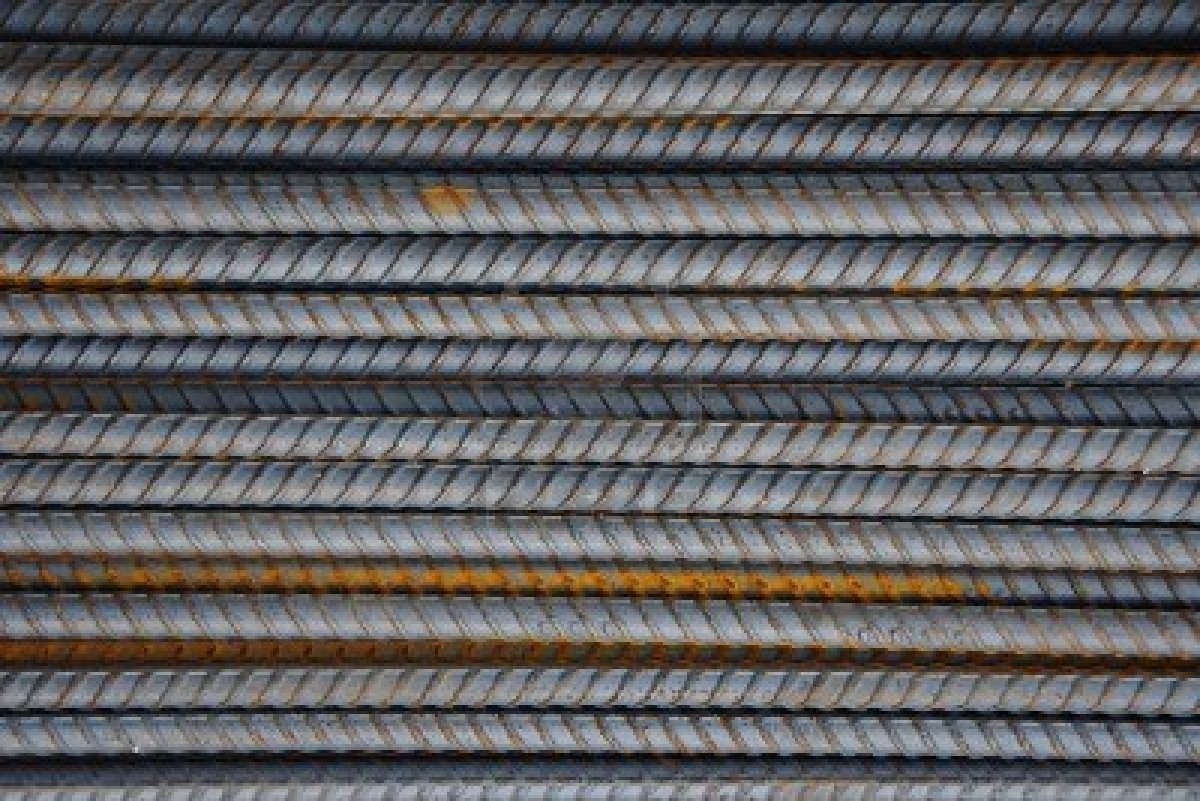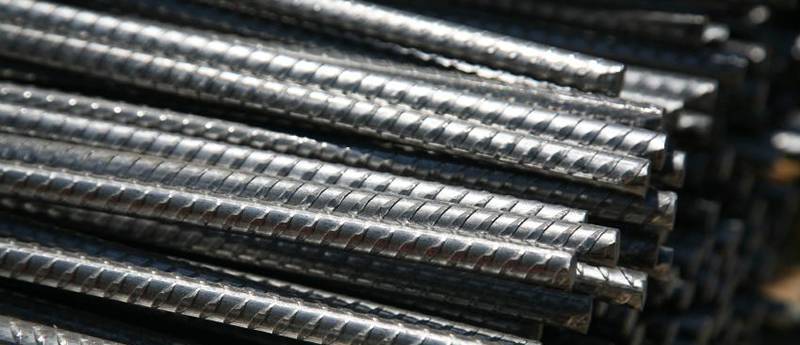Rebar
Reinforcing steel or rebar, rebar or reinforcing rods formerly also serves as reinforcement ( reinforcement ) of reinforced concrete structures and is shed after installation in the formwork with concrete. In Austria it is also referred to as TOR steel or Rippentorstahl - after the originally used method of cold working by torsion, let the patented its inventor Rudolf Schmidt in 1935.
- 2.1 Reinforcing steel bars
- 4.1 Development in Germany
Form and character
Now comes in Germany only concrete steel with a characteristic flow or yield strength of 500 N / mm ² are used. The required characteristics are controlled, for example, in DIN 488 ( formerly DIN 1045-1 ) or the European standard EN 10080. The reinforcing steel is produced in different forms. In Germany are available:
- Concrete reinforcing steel B500B ( DIN 488 ) (formerly " BSt 500 S (B)" ), and as hot rolled and ribbed steel bars with diameters of 6, 8, 10, 12, 14, 16, 20, 25, 28, 32 and 40 mm lengths up to 18 m (as Sonderwalzung to 24 m)
- Betonstahlmatten B500A and B500B ( DIN 488 ) (formerly " BSt 500 M ( A) and (B)" ), in different variants, as finished welded mats of ribbed and profiled and cold worked steel bars ( ductility class A) or hot-rolled rebar ( ductility class B ) with diameters from 6 mm to 14 mm (14 mm only in highly ductile model, 6 to 12 mm in normalduktiler or execution of highly ductile, welded mesh in ductility class B ( high ductility ) are manufactured on demand, no storage )
- Reinforcing steel coils B500B ( DIN 488 ) (formerly " BSt 500 S (B)" ) hot-rolled, in diameters ranging from 6 to 16 mm and or B500A ( DIN 488 ) (formerly " BSt 500 S (A)" ) kaltgerippt, in the diameter range from 6 to 12 mm for further processing on straightening and cutting or automatic stirrup benders.
- Reinforcing wire B500A B500A P G profiled and smooth ( according to DIN 488 ) in the diameter range 4-12 mm for the reinforcement of eg Reinforced concrete pipes or aerated concrete (previously aerated concrete ) or manhole.
- Girder as rigid reinforcement in half prefabricated ceilings and walls
The modern concrete steels are with regard to their deformation properties by an elastic modulus 200000-210000 N / mm ² and marked the division in ductility classes. In Germany there is the normalduktile class A for cold-formed steels with a ratio between tensile strength and yield strength of at least 1.05 and a steel strain at the maximum load of at least 2.5 % and the ductility class B for the hot-formed steels or with at least 1.08. 5%. In addition, the high ductility earthquake steel class C must be mentioned, which is used in parts of Europe and has a reduced yield strength of 450 N / mm ², with a ratio between tensile strength and yield strength of at least 1.15 and a steel strain at the maximum load of at least 8 %.
The thermal expansion coefficient for steel is in the middle as in concrete [1 / K], the thermal conductivity coefficient of 50 [W / (m · K) ], however, differs from the concrete. Today's concrete steels are all suitable for welding.
An important property of the reinforcing steel which is combined with the surrounding concrete. To improve the bonding ribs are rolled up or rolled on. The ribs have a maximum height of 4.5 % and a distance of 60 % of the rod diameter. The ribs a local interlocking between the concrete and the steel is achieved, which allows optimum power transmission over a short bond length.
Corrosion protection
Possible causes for the corrosion of the reinforcing steel are flaws in the concrete through cracks, honeycombing or insufficient concrete cover, allow the action of chlorides by deicing salt and marine atmosphere.
The cement paste contained in the concrete to protect the reinforcing steel with its alkaline environment with a pH of 12-14 prior to corrosion. At a value <10 this protection is the so-called passivation, no longer guaranteed. As the concrete with time from the outside inwards carbonated ( reaction of the alkaline hydrated lime present in the concrete with atmospheric carbon dioxide to lime (Ca (OH) 2 CO 2 → CaCO 3 H 2 O) ) and thereby decreases in its pH value, must reinforcing steel to be completely enclosed and with a sufficient concrete cover. The binding together of the individual reinforcing elements by means of wire ( racking ), and the installation of spacers (e.g., clamped- plastic wheels or small blocks of concrete ) ensuring between the shell and reinforcement, the reinforcing steel is in the planned pre- position in the component with sufficient concrete cover.
For improved corrosion protection reinforcing steel can be coated with epoxy or hot-dip galvanized. Stainless steel is another option. Relatively new is the fiberglass reinforcement. For additional smaller cross-sections are textile reinforcements, especially fiberglass scrims, apply.
To protect against corrosion of the reinforcing steel due to carbonation or chloride penetration can also be a Cathodic protection with impressed current anode (actually only one polarization ) can be controlled via a rectifier with a protection current, to be applied. This can for example come in bridge for use.
All variants are subject to supervision in Germany. That is, notwithstanding produced by the standard structures require a building approval for the components used or a specific approval for the particular construction project by the Landesbaubehörde. A list of officially approved reinforcement elements leads the German Institute for Building Technology.
Protective systems such as the impregnation of the concrete surface with a hydrophobizing agent or the application of coatings, also serve the improved corrosion protection of the reinforcing steel, particularly when the concrete has been carbonated to the depth of the steel ( for example, during repair).
Identification
Reinforcing steel bars
Today rebars have two rib surfaces. One of the surfaces characterized by a particular arrangement of the inclined ribs of the concrete steel grade. The other face bears the marks of the manufacturing plant, which follow each other at least on each meter. These begin with two enlarged oblique ribs, followed in each case between the widened ribs inclined at first the country, then the work in question. The field for the work may be divided into tens and units digits.
Notes:
There are both in the group of countries as in the 8 9 Polish, Turkish and Moldovan rebar manufacturer.
In Austria Marienhütte (Graz) is currently producing reinforcing steel only in the steel mill.
Further reinforcing elements
Threaded steel is a concrete or prestressed steel with helical ribs formed thread-like and is manufactured by different companies. It has been developed for the reinforcement technology in order to allow a mechanical connection Screw. Today, the threaded steel is also used in geotechnical engineering as injection pile and ground anchors.
As a replacement for shear reinforcement, there are double -headed anchors and dowel bars.
In components with specific requirements for corrosion, machining or electrical / magnetic properties can be used also approved non-metallic FRP reinforcement.
History
Inventor of the steel reinforcement was the Frenchman Joseph Monier, according to him is called the reinforcement and concrete reinforcing steel ( Under Construction jargon often as the verb " criticize " pronounced). Monier was a gardener and was annoyed that his flower pots were destroyed concrete from the root system too often. Other older but still common names are reinforcing steel (as opposed to structural steel ) or reinforcing steel (as opposed to stressing steel ).
Cold deformed by torsion reinforcement steels exhibit increased resistance. They are called TOR steel and have long been characterized by a twisted longitudinal rib of the roll supernatants favorable effect on the bond with the concrete. TOR steel was invented by Austrian Rudolf Schmidt in 1936/1937. The term is still in use in Austria.
Development in Germany
Until the mid- 1930s, no special reinforcing bars were used as reinforcement, but rods, flat bars and profiles with a smooth surface and a yield point at or above 250 N / mm ². The activation of the viability of the smooth steel was carried out less by the bond between concrete and steel as mainly due to the anchoring hook and loop. The Isteg steel, consisting of two wires made of smooth steel that have been twisted into a 2- drähtigen strand, was from 1933, the first special German steel concrete composite with improved properties. At the same time, the wire mesh was approved in Germany, consisting of mats or rolls (up to 6 mm). From 1935 ( twisting ) were developed by round steel high-strength reinforcing steels, initially without transverse ribs for the purpose of saving material by twisting. 1937, the rebars were divided into groups. Group I included the BSt 22/34 with a minimum yield strength of 220 N / mm ², the group II the BSt 34/50 with a 340 N / mm ², the group III the BSt 42/50 with a 420 N / mm ² and group IV meets today's concrete steels. In recalculations or reinforcements of old buildings, the strengths of the old steel grades must be considered in static calculations.
As of 1959, the quality diagonally ribbed Rippentorstahl was approved by the building as rebar IIIb. This was a strength-increasing additionally ( in the factory) by twisting ( twisting of torsion - hence the "gate" in the name) cold worked. Today's fin shape was eventually developed from 1961 for a better fatigue strength of the reinforcing steel IV.










